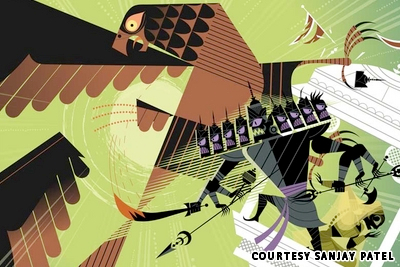Ramayana Renewed: Pixar Cartoonist Revamps the Ancient Hindu Story
By Aarti Betigeri | Мар 18, 2010

Growing up, cartoonist Sanjay Patel only had a dim awareness of the great Hindu epic the Ramayana, his bare-bones knowledge coming from his Gujarati parents’ colloquialisms. “Every time someone sneezed in the house, my mother would say Sitaram,” says Patel. “Only later did I understand they were saying Sita and Rama, and it was auspicious to say that.”
The Ramayana tells the story of the god king Rama who — with the help of the monkey god Hanuman — rescues his wife Sita who has been kidnapped by the evil demon Ravana during the couple’s long forest exile. Suspecting his wife’s purity may be in question after her detention, he banished her to the forest even though she proved her fealty by walking through fire.
That’s the abridged, shortened, nutshell version. For “The Lord of the Rings” has nothing on the Ramayana when it comes to length.
Some 25 years after grasping the basics of the story, Patel has produced what should become one of the defining accounts of the epic tale in a span of 100 illustrations, titled “Ramayana: Divine Loophole”. It’s certainly not the first time a cartoon book version has been produced, but it’s certainly the most stylish and the most internationally appealing.
In the book’s title the divine loophole is a reference to Rama. Since Brahma gives Ravana the power to be indestructible from both gods and demons he becomes a great menace. In an effort to restore balance Vishnu realized that there was a loophole in Ravana’s power and that was for him to be reborn as a man. Since Ravana had no protection from a god reborn as a man, we get the divine loophole, the avatar of Rama.

In Patel’s Ramayana, his drawings are angular and sometimes starkly graphic, most often with a limited colour palate, evoking elements of the mid-20th-century design language the cartoonist loves. An artist at California’s Pixar for 13 years, Patel has worked on features including “Monsters Inc”, “Cars”, “The Incredibles” and “A Bug’s Life.” Work, he is not shy to say, has deeply influenced his personal projects.
For example, “I was really touched by the movie Up, and was impressed that the studio took on such a risky project, that had such weighty themes.” He says his Ramayana is of a similar nature. “It has deep themes in there but on the surface it looks like colorful candy. There are so many people working in animation that are all style and no substance, I wanted to bring some style to the substance, and bring it to a younger generation, and to make it accessible to people like you and I.”
Patel is referring to second-generation non-resident Indians, who grew up wedged between two cultures, sometimes only receiving snippets of their parents’ heritage.

“Growing up, I watched a lot of Looney Tunes, read a lot of Marvel comics, and watched a lot of Japanese animation like Robotech,” says Patel.
But at the same time, his staunchly Hindu parents would corral him and his brother into daily prayers at a home temple, watched over by a picture of Hanuman standing on a mountain. “I didn’t realise it at the time, but the Ramayana was there in front of me as I grew up.”
It took Patel a good year just to read the story. “I read about four different versions, and dozens of childrens’ book versions,” he says. The subject matter, that of an estranged married couple, became closer to Patel than he might have anticipated: his own decade-long marriage broke down while he was working on the book. “It was happening in the middle of it. It delayed things,” he says.
“Once I realised I was going to get divorced, for the first time ever in my life I wasn’t able to draw. I couldn’t pick up a pen for six months,” he says.
In a strange parallel, cartoonist Nina Paley had, around the same time, picked up a pen in the wake of her own broken marriage and produced a feature-length cartoon film, telling the Ramayana from Sita’s perspective, Sita Sings the Blues. (CNNGo article)

Despite the overlap, Patel and Paley are both big fans of each other’s work and hope the new take on this ancient scripture might spur a new generation of Ramayana readers.
“There’s nothing original in what I’m doing,” says Patel. “The only thing I’ll take credit for is doing artwork that’s [bringing] mid-century design and ancient myth together. If people see parallels between my work and Nina’s, it’s because we’re all drawing on the same legacy.”
That very legacy is one that Patel now can see reflected in his own life trajectory.
“An aunt pointed out something very astute: she said Rama’s story is a tragedy, he was the dutiful one. But Krishna [along with Rama, an avatar of Vishnu] broke all the rules, had lots of lovers and liked to party,” says Patel.
“She said perhaps the lesson of Vedic culture is that there are times in our life when we have to behave dutifully like Rama, and others when we can be playful like Krishna and not follow any rules. In my opinion, that’s the lesson of the text.”















